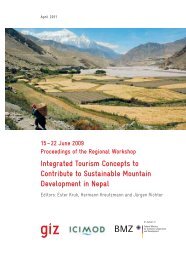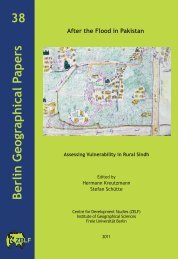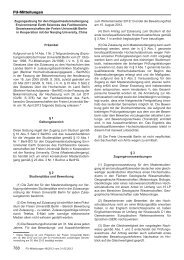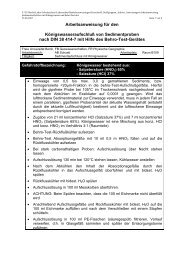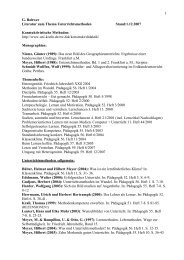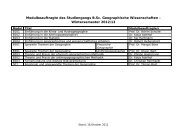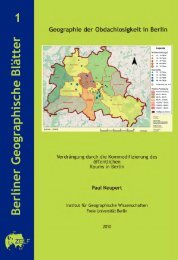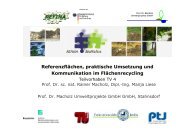Pastoralism and Rangeland Management on the Tibetan Plateau in ...
Pastoralism and Rangeland Management on the Tibetan Plateau in ...
Pastoralism and Rangeland Management on the Tibetan Plateau in ...
Create successful ePaper yourself
Turn your PDF publications into a flip-book with our unique Google optimized e-Paper software.
are exported <strong>in</strong> crude form i.e. <strong>in</strong> <strong>the</strong> form of roots, bark, seeds, leaves <str<strong>on</strong>g>and</str<strong>on</strong>g><br />
branches. However, <strong>the</strong>re is no systematic method for medic<strong>in</strong>al plant collecti<strong>on</strong><br />
<strong>in</strong> <strong>the</strong>se mounta<strong>in</strong> regi<strong>on</strong>s (Hussa<strong>in</strong> 2004).<br />
3.2.2 Issues related to Medic<strong>in</strong>al <str<strong>on</strong>g>and</str<strong>on</strong>g> Aromatic Plants<br />
Some of <strong>the</strong> key issues <str<strong>on</strong>g>and</str<strong>on</strong>g> challenges related to medic<strong>in</strong>al <str<strong>on</strong>g>and</str<strong>on</strong>g> aromatic plants<br />
(MAPs) are lack of au<strong>the</strong>ntic <str<strong>on</strong>g>and</str<strong>on</strong>g> scientific data about <strong>the</strong> actual potential <str<strong>on</strong>g>and</str<strong>on</strong>g><br />
status of MAPs as threatened, endangered <str<strong>on</strong>g>and</str<strong>on</strong>g> commercial viability, value<br />
cha<strong>in</strong> analysis to f<strong>in</strong>d miss<strong>in</strong>g l<strong>in</strong>ks <str<strong>on</strong>g>and</str<strong>on</strong>g> cost to price variati<strong>on</strong>s <str<strong>on</strong>g>and</str<strong>on</strong>g> actual<br />
benefits to pastoral communities, patent<strong>in</strong>g <str<strong>on</strong>g>and</str<strong>on</strong>g> <strong>in</strong>tellectual property rights<br />
<str<strong>on</strong>g>and</str<strong>on</strong>g> safeguard<strong>in</strong>g local knowledge <str<strong>on</strong>g>and</str<strong>on</strong>g> rights of local people <str<strong>on</strong>g>and</str<strong>on</strong>g> protecti<strong>on</strong> of<br />
<strong>in</strong>digenous knowledge.<br />
C<strong>on</strong>servati<strong>on</strong> status of MAP is not known to draw updated red list for management<br />
<str<strong>on</strong>g>and</str<strong>on</strong>g> biological threshold level of different species not understood.<br />
Key plant resources available <strong>in</strong> wilderness are depleted <str<strong>on</strong>g>and</str<strong>on</strong>g> when farmers are<br />
mobilized for n<strong>on</strong>-profitable cultivati<strong>on</strong> of MAP, <strong>the</strong>re is over-harvest<strong>in</strong>g of<br />
species from <strong>the</strong> wild. Stable MAP bus<strong>in</strong>ess requires susta<strong>in</strong>able returns of <strong>the</strong><br />
profit <str<strong>on</strong>g>and</str<strong>on</strong>g> susta<strong>in</strong>able producti<strong>on</strong> with limited yearly producti<strong>on</strong> fluctuati<strong>on</strong>.<br />
Collecti<strong>on</strong> from wild resources always poses <strong>in</strong>c<strong>on</strong>sistent producti<strong>on</strong>. Currently<br />
collecti<strong>on</strong> does not match with <strong>the</strong> productive capacity of <strong>the</strong> habitat. Species<br />
of high dem<str<strong>on</strong>g>and</str<strong>on</strong>g> are over-harvested <str<strong>on</strong>g>and</str<strong>on</strong>g> low dem<str<strong>on</strong>g>and</str<strong>on</strong>g> under-harvested. Collectors<br />
are compet<strong>in</strong>g for early harvest<strong>in</strong>g <str<strong>on</strong>g>and</str<strong>on</strong>g> some time pre-fruit<strong>in</strong>g collecti<strong>on</strong>,<br />
if <strong>the</strong>y will wait till <strong>the</strong> maturity, o<strong>the</strong>r will get <strong>the</strong> chance to harvest. They<br />
mostly uproot <strong>the</strong> plant even if <strong>on</strong>ly flowers or leaves are needed.<br />
Some species are over-harvested to <strong>the</strong> extent to be declared as threatened<br />
species. These <strong>in</strong>clude: Saussurea costus, Valeriana jatamansi, Polyg<strong>on</strong>atum<br />
multiflorum, Angelica glauca, Podophyllum hex<str<strong>on</strong>g>and</str<strong>on</strong>g>rum, Dioscorea deltoidea,<br />
Asparagus adscendense, Geranium wallichianum, Viola odorata, Ac<strong>on</strong>itum spp;<br />
Polyg<strong>on</strong>um amplexicaule, Glycyrrhiza glabra, Ferula asafoetida, Morchella esculenta,<br />
Morchella c<strong>on</strong>ica, Ephedra gerardiana, Jur<strong>in</strong>ea macrocephala <str<strong>on</strong>g>and</str<strong>on</strong>g> Pae<strong>on</strong>ia<br />
emodi. (Rahim 2004)<br />
3.3 Gemst<strong>on</strong>e: M<strong>in</strong><strong>in</strong>g, cutt<strong>in</strong>g <str<strong>on</strong>g>and</str<strong>on</strong>g> polish<strong>in</strong>g<br />
There is a great potential for producti<strong>on</strong> of gemst<strong>on</strong>e <str<strong>on</strong>g>and</str<strong>on</strong>g> m<strong>in</strong>eral products<br />
<strong>in</strong> Gilgit-Baltistan. Major deposits of corundum (ruby <str<strong>on</strong>g>and</str<strong>on</strong>g> sapphire) beryl<br />
(emerald <str<strong>on</strong>g>and</str<strong>on</strong>g> aquamar<strong>in</strong>e), topaz, opal, pegmatite, mica, sp<strong>in</strong>el, pyrite <str<strong>on</strong>g>and</str<strong>on</strong>g><br />
sedimentary deposits of gold <str<strong>on</strong>g>and</str<strong>on</strong>g> alluvial deposits of ruby are reportedly found<br />
194



